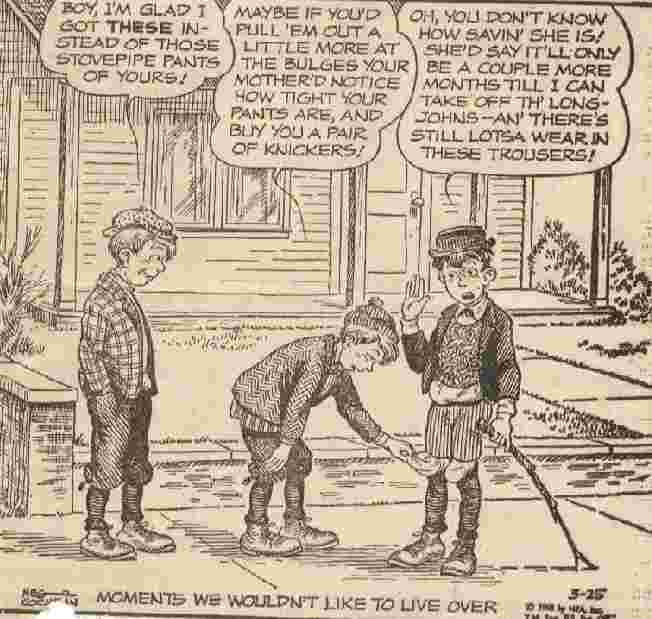
Knee Pants: Popularity

Figure 1.--This cartoon by Neg Cockran appeared in many American newspapers as
part of a synicated series called "Out Our Way" in 1968. It is a nostalgic
look backward to an embarrassing moment in a boy's childhood and the American
era of about 1912 or 1913 when knickers were rapidly replacing knee pants as
standard wear for boys. Cartoons like this are interesting because they illustrate concerns of contemporary boys that are completely lost on modern boys.
|
|
Kneepants and knickers, or a least knee-lengthpants withblouced leg hems, appeared at about the same time. We note both being worn in the 1850s, but by the 1860s, kneepants were clearly more common. We are not sure why this was, but guess that straight-leg kneepants were easier to sew than blouse-leg pants. This continued until the early 20th century when more and more boys began wearing knickers. We are not sure as to how boys in the 1910s and 20s viewed the two styles. Although knickers were not a new style, clearly boys began seeing knickers as a more modern style. Interestingly some parents, especially in Europe, continued for some time to see kneepants as more appropriate for formal dresswear. We suspect that a major factor was that kneesocks rather than longstockings requiring a stocking supporter could be worn with knickers.
Boys' View
Kneepants and knickers, or a least knee-lengthpants withblouced leg hems, appeared at about the same time. We note both being worn in the 1850s, but by the 1860s, kneepants were clearly more common. We are not sure why this was, but guess that straight-leg kneepants were easier to sew than blouse-leg pants. This continued until the early 20th century when more and more boys began wearing knickers. We are not sure as to how boys in the 1910s and 20s viewed the two styles. Although knickers were not a new style, clearly boys began seeing knickers as a more modern style.
Parent's View
Interestingly some parents, especially in Europe, continued for some time to see kneepants as more appropriate for formal dresswear. We suspect that a major factor was that kneesocks rather than longstockings requiring a stocking supporter could be worn with knickers.
Winter Underwear
Although not common today, most children except in tropical countries, used to wear long winter underwear. This cartoon by Neg Cockran appeared in many American newspapers as
part of a synicated series called "Out Our Way" in 1968. It is a nostalgic
look backward to an embarrassing moment in a boy's childhood and the American
era of about 1912 or 1913 when knickers were rapidly replacing knee pants as
standard wear for boys. Cartoons like this are interesting because they illustrate concerns of contemporary boys that are completely lost on modern boys. The two boys who have already got their knickers are
making fun of their friend who is still forced to wear knee pants. The boys
with knickers buckle them below the knee (which is fairly advanced and
daringly "modern") although they still wear long black stockings. The boy
with the knee pants is embarrassed because his long-legged union suit shows
between the tops of his stockings and the hem of his knee pants and you can
also see that his stockings are being held up with hose supporters, probably
attached to a waist. Notice the variety of hats the boys are wearing. The
boys with knickers wear a stocking cap in one case and a flat cap of sorts in
the other case, while the boy with the knee pants wears a more old-fashioned
hat with a crown, a decorative band, and a small brim. Notice also the
reference to the ritual of making boys wear long underwear during the cooler
months. The boy with the "stovepipe" pants says that his mother doesn't want
to buy him the new-style knickers while there is a still a few more months'
wear in the knee pants. But his embarrassment will be a little less at this
point, even if his mother won't buy him the new knickers which he would like,
because at this time he will be allowed to switch from "longjohns" to summer
underwear that won't show underneath the stockings. There is a fair amount of
amusing social commentary about boys' clothing around 1910-1920 in this
cartoon, which is quite revealing historically about boys' attitudes at the
time. I wonder if the cartoonist, Cockran, is recalling a mortifying moment
from his own boyhood.
HBC

Navigate the Boys' Historical Pants pages:
[Return to the Kneepants]
[Breeches]
[Knickers]
[Short pants]
[Long pants]
Navigate the Boys' Historical Clothing Web Site:
[Introduction]
[Activities]
[Biographies]
[Chronology]
[Cloth and textiles]
[Clothing styles]
[Countries]
[Topics]
[Bibliographies]
[Contributions]
[FAQs]
[Glossaries]
[Satellite sites]
[Tools]
[Boys' Clothing Home]
Created: January 26, 2004
Last edited: January 26, 2004



